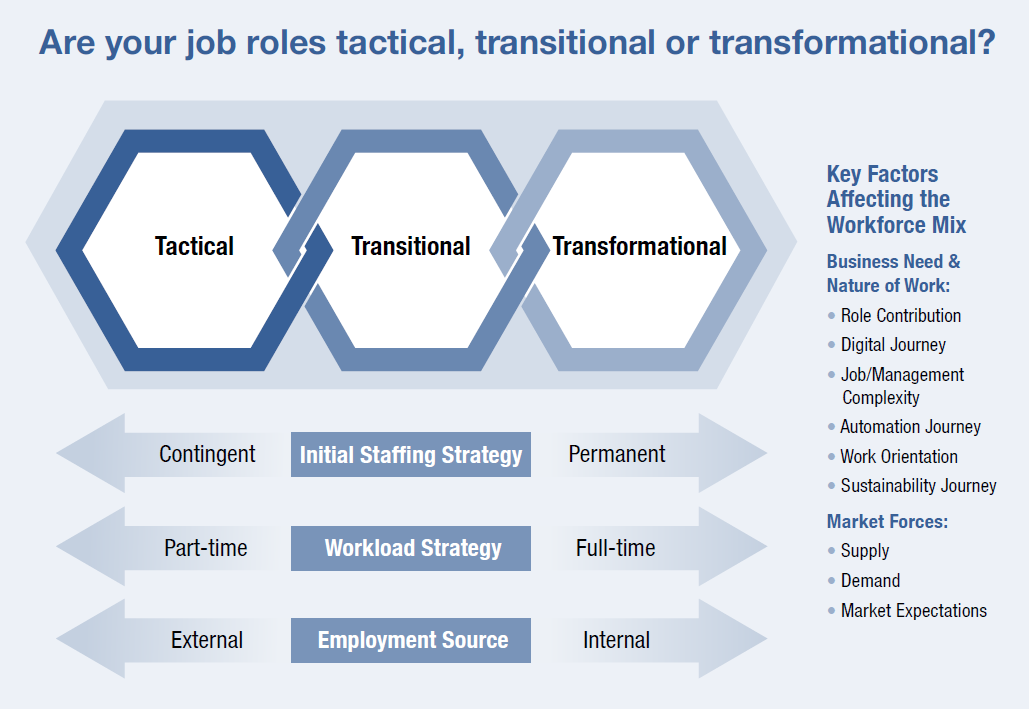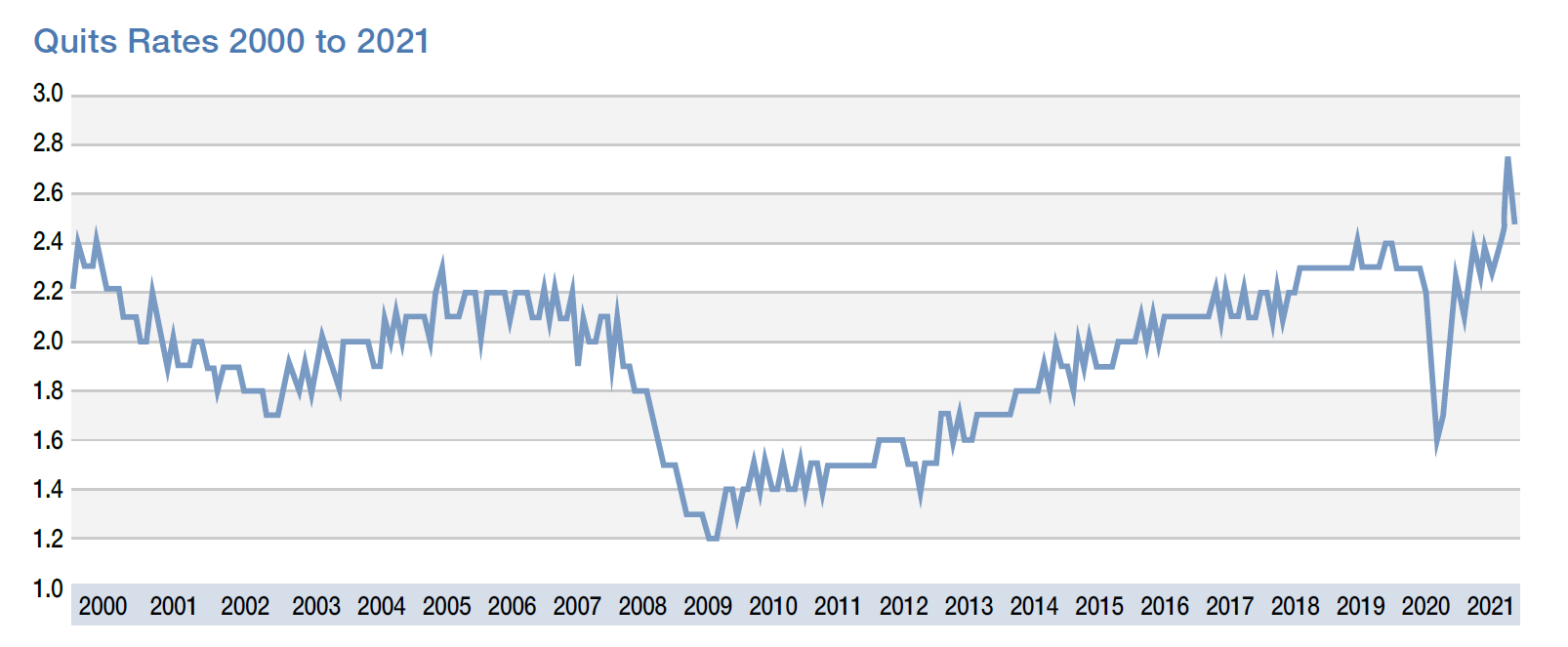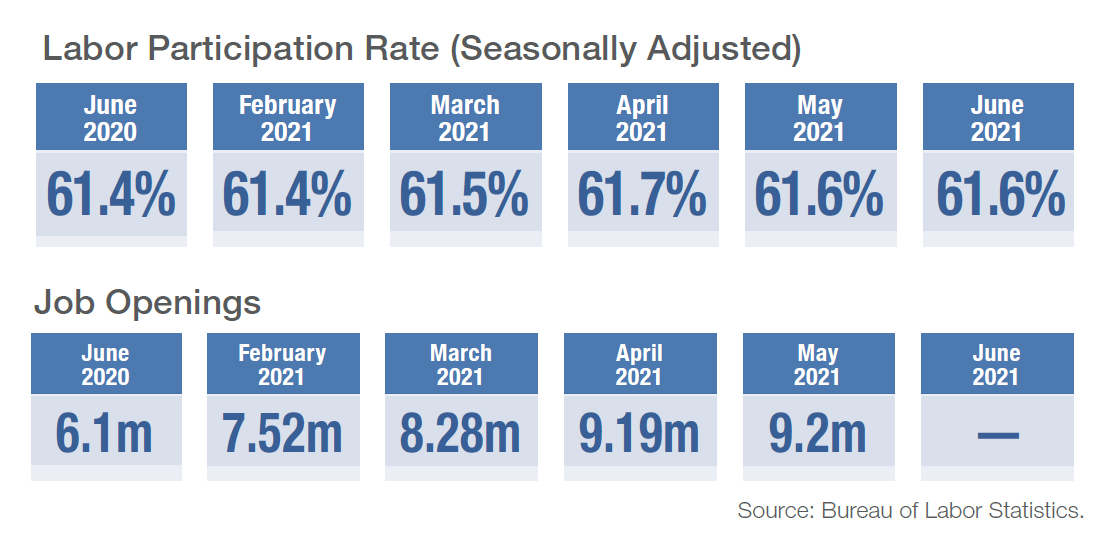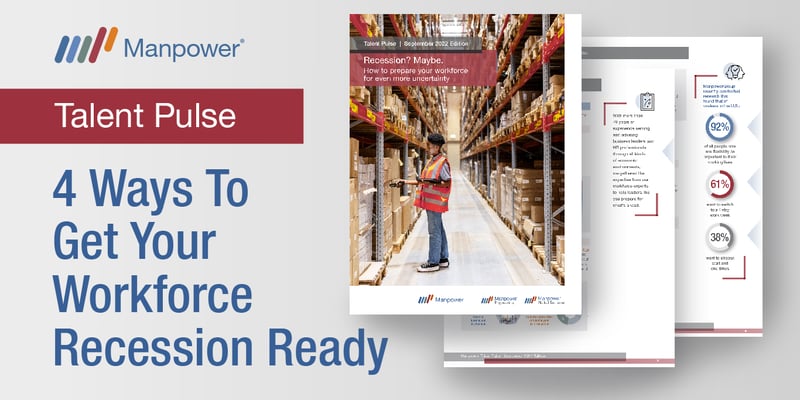To say a lot has happened in the last 18 months is an understatement. A global pandemic, accelerated automation, social crises — they’ve all impacted the workforce in different ways and complicated employers’ strategies. With rising costs, market uncertainty, and rapid technology advances —some of which have been accelerated by the Covid-19 pandemic — employers are finding it even more challenging to create the type of workforce strategy that enables success.
As we emerge on the other side of the pandemic, the economic recovery is happening even faster than predicted, exacerbating the dilemma of an already talent-strapped U.S. labor force. However, workers are in short supply for a myriad of reasons. Our Talent Shortage research found that nearly one-third of employers in the U.S. have difficulty hiring talent, weighted heavily in operations/logistics and manufacturing/production roles. In an environment such as this, determining the proper mix of temp, perm, and temp-to-perm workers is critical.
"We’re in the middle of the great reawakening... The crisis has changed us. We are changed. People are reprioritizing one life — they want to live from work versus work from home, and we’re in the middle of this huge dynamic of an empowered worker in our country and the ramifications can be scary. But they’re so incredibly fascinating to watch unfold in front of us." - Becky Frankiewicz, President, ManpowerGroup North America, As shared on the WorkShifting roundtable, Bloomberg Businessweek
What’s Causing the Turmoil?
The basic economics of work have changed. The pandemic forced many people to pause and reassess their priorities. This means there is no one cause for the worker shortage but rather a number of factors at play, leading to less people going to work.
The federal stimulus, extended unemployment benefits, and rising state minimum wages, combined with wage increases by large employers like Amazon and Costco, means that the effective minimum hourly wage is surging past $15.
There are other major factors at play as well. Many are still hesitant to take public-facing roles due to health fears. Others have ongoing child care issues. According to our 21 Trends for 2021 research, worker concerns for family and health have elevated to critical consideration.
The quit rate, or percentage of workers who quit their jobs, surpassed the 20-year high in April and continues to rise. We’re seeing workers quit jobs at historic rates with some of the highest increases of quit rates in leisure and hospitality (5.3%) and retail trade (4.0%).
According to the Wall Street Journal, the shift by workers into new jobs and careers is driving employers to raise wages and offer promotions to keep hold of talent. And all this movement signifies that employees are feeling confident about their new job prospects even despite the continuation of elevated employment rates. It all boils down to high competition by employers for workers —competitiveness that is driven by the shrinking pool of willing workers and fast-paced bounce-back of demand for services. As a result, the Bureau of Labor Statistics reports that the average hourly wage across all private industries (nonfarm) rose from $29.35 in June 2020 to $30.40 in June 2021—and all indications are that it will continue to rise.
The fact of the matter is, it’s an employee’s market where workers get to choose the most attractive offer with the best job, best pay and best conditions. What workers want has evolved and at the top of that list is increased pay, more flexibility and greater purpose in their job. Workers are firmly in the driver’s seat. As costs are rising – from labor to raw materials – it all has an impact on consumer pricing and we all feel the squeeze.
According to a survey in June 2021 by Morning Consult, 29% of those actively collecting unemployment benefits said they turned down job offers during the pandemic. In response to a follow-up question, 45% of that group said they turned down jobs specifically because of the generosity of the benefits.
What Can Be Done?
How do you construct a workforce that will be resilient in the face of fast growth, a talent shortage, general uncertainty and rapid change? The key may be in the mix: the mix of temp, perm and temp-to-perm workers.
However, you can’t determine whether you have the right workforce mix unless you know more about your current state: both what your workforce is costing you and how you stack up to your competition. Manpower’s Total Cost of Workforce calculator will help you determine your true workforce costs.
The average company’s costs fall into 3 main buckets:
Labor – 40%
These include wages, benefits and acquisition costs
Opportunity – 35%
Costs such as overtime, turnover, unfilled orders, and supervisor time
Hidden Costs – 25%
Items like safety, compliance, unemployment and training
The costs that fall under Opportunity and Hidden Costs could be directly impacting your labor costs. For example, if you’re understaffed for too long, overtime and even injury rates may be rising, which could easily result in higher turnover. And a talent shortage could result in missed or unfilled orders. It’s critical to see your entire workforce ecosystem in order to make the best decisions for your future.
The next step to creating a resilient workforce through the right mix is understanding how you stack up to your competitors in five key areas: accessibility, labor market conditions, contingent labor relationship, work environment, and employment/job competitiveness. Together, these factors strongly influence a company’s ability to attract, compete for, and retain great people. Manpower has another proprietary tool, the Manpower Workforce Success Index (WSI) that helps do just that. The WSI is a comprehensive assessment of the health of your organization’s talent environment and its competitive ability to attract and retain talent.
With a WSI report, you’ll learn:
• What opportunities exist to improve labor attraction
• How your organization’s brand is perceived by the available workforce
• Insights into labor market availability, impacts on pay rates, value of safety programs, and more.
These tools create a powerful story about your current workforce and equip you with the information you need to make data-backed decisions for the future success of your company.
What is the Right Workforce Mix?
The right workforce mix is the one that saves your organization money and optimizes your investment in your workforce, all while maintaining the high-quality products and services your customers count on. It can take many forms and the right workforce mix is different based on each company’s unique needs. The question is how and where you need to build in adaptability and resiliency, and where you need to make more permanent, long-term bets. Knowing when and how to leverage permanent, temporary, temp-to-perm workers, or a mix is the million-dollar question. And the answer is driven by the unique knowledge you gain from better understanding your workforce cost, your position amongst competitors and the key factors below that influence the right workforce mix for your organization.
The right workforce mix must take into account these factors:
1. Business Needs: What are you trying to capture? Who are you trying to beat? Based on that, how do you deploy talent to win and what talent is most critical to driving that? There’s also a question of what you can afford to do relative to what is most important to you.
2. Market Forces: Talent supply, worker demand, market expectations, economic growth or downturns – while most of the macro market forces are shared by all, they all play a big role in how you approach your individual workforce mix and influence the unique levers you can pull to achieve success.
3. Variability: Organizations will require varied flexibility at certain times for certain roles and its workforce mix should be adaptive enough to enable that flexibility. Short or long-term skill needs, project-based work, and varying production demands impacting volume and schedules all influence the need to optimize a workforce mix through variable work options including temp, temp-to-perm, or permanent roles.
4. Strategic Role Types and Skill Levels: Are your job roles tactical, transitional, or transformational?
• Tactical roles: Often the team members working to scale routine and highly managed core operations and skill areas or meet certain functional and regulatory basics. Contingent lends itself to tactical roles.
• Transitional roles: Workforce team members who continue that effort but add more skills or take on more complexity, dynamic tasks and decisions, while flexing between tactical and transformational categories. Transitional roles tend to include a mix of temporary and permanent talent.
• Transformational roles: Those who are often tasked with change making, innovation, creating new value or executing specific projects often with more unique goals or less routine work patterns. Draw from multiple partners for your transformational talent. While 80% of transformational roles will likely come in the form of permanent talent, when it’s most scarce, you may need to engage specialist firms for project-based talent.

Work Types: What’s the advantage?
Permanent/Direct Hire: Go to the market to find talent that you need
• Maximize attraction for highly sought-after talent
• Build a bench of adjacent talent with the ability to quickly skill shift when supply is scarce
• Increase the likelihood of retention by messaging: “this role is here to stay”
• Reduce the opportunity costs of lost knowledge and repeated productivity ramps
• A good choice for core, transformational roles and where expert skills
and the right fit are pivotal
Temp: Hire temp, part-time or freelance workers
• Get talent onboard fast for projects or other work of uncertain duration
• Avoid moving core workers away from their current duties.
• Quickly get ahead of overtime costs and avoid worker burnout
• A good choice for non-strategic, non-core roles requiring more general skills
• Also a good choice for strategic expert roles with high variability
Temp-to-Perm: Hire temp with option to convert to permanent employee
• Test out talent on-the-job to find the best fit people for permanent roles
• Accelerate core recruitment with a candidate pool eager for advancement, at the ready
• Protect your organization from the risk of direct hiring during uncertain times
• A good choice for transitional roles that maintain some variability
Ultimately, those companies that come out on top will build in the flexibility they need within their workforce to adapt to changing factors, while protecting and retaining their core roles and talent. With a valuable knowledge and insights from Manpower, you’ll be well-equipped to make the right decisions to come out on top even in this unsettled market.








Comments